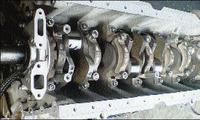
Above: Crankshaft balanced with drive plate, balancer and pulley fitted to ensure smooth rev operation.

The camshaft is important to keep the vehicle well lubricated and running smoothly. - Contributed
WHAT IS the difference between the crankshaft and the camshaft? Are they related by any means to the operation of a motor vehicle? Is the crankshaft associated with the lubrication system? Let's find out.
Both the crankshaft and the camshaft play an integral part in the operation of a motor vehicle. "When you think of the crankshaft you think of power. It plays an essential role in the lubrication system," says Kurt Harding, a St Andrew auto mechanic.
Some passages are placed in the shaft in a manner which allows oil to lubricate the main and connecting-rod bearings. Like the connecting rods, the main bearings have specific insert bearings designed to minimise friction between the crankshaft and the main-bearing caps.
steady rotary motion
One of these insert bearings is made to prevent the crankshaft from moving forward or backward. The crankshaft, Harding explains, converts the up-and-down reciprocating action of the pistons into a steady rotary motion to pin the flywheel.
"The flywheel is that huge, round, heavy piece of metal that makes it possible to idle the engine smoothly at relatively low speeds," the mechanic explains. Without its inertia, it would be impossible to smooth out the firing impulses as the fuel/air mixture is ignited in each cylinder.
Harding further explains that motor CAS with standard transmission, has a clutch assembly that is bolted to the flywheel in order to transmit the engine's power to the transmission. With the automatic transmission, there is no flywheel. "What it has is a unit known as the drive plate. This is attached to the rear of the crankshaft."
It must be noted that a series of metal caps hold the bearing inserts and by extension, they secure the crankshaft to the engine block. Motorists should be aware that the ends of the crankshaft are fitted with seals to prevent oil from leaking out of the engine. Also, a pulley is fitted to the front of the crankshaft to drive the belts that operate the generator, water pump, alternator, air conditioning and power steering.
The camshaft is located in the engine block. It pushes directly against the vale lifters to open and close these valves. According to Harding, on many of our motor vehicles, the camshaft also operates the ignition distributor, the fuel pump, and the oil pump.
rotate regularly
Additionally, he says rotating once for every two turns of the crankshaft, the camshaft is very sturdy and the cam surfaces are case-hardened to minimise and tear.
The cam should be properly lubricated. If they are not, case-hardening can be penetrated on one or more of the cams, and the softer metal underneath soon wears away. "Now, when this occurs, car owners must realise the valve section on one or more cylinders refuses to function and this means trouble for an engine.
Motorists must be aware that the bearings which support the camshaft seldom gives problems. However, they should be carefully examined and replaced when the engine is being overhauled or rebuilt. "Worn camshaft bearings can cause a fall in oil pressure and by extension result in inadequate lubrication throughout the engine," Harding warns.